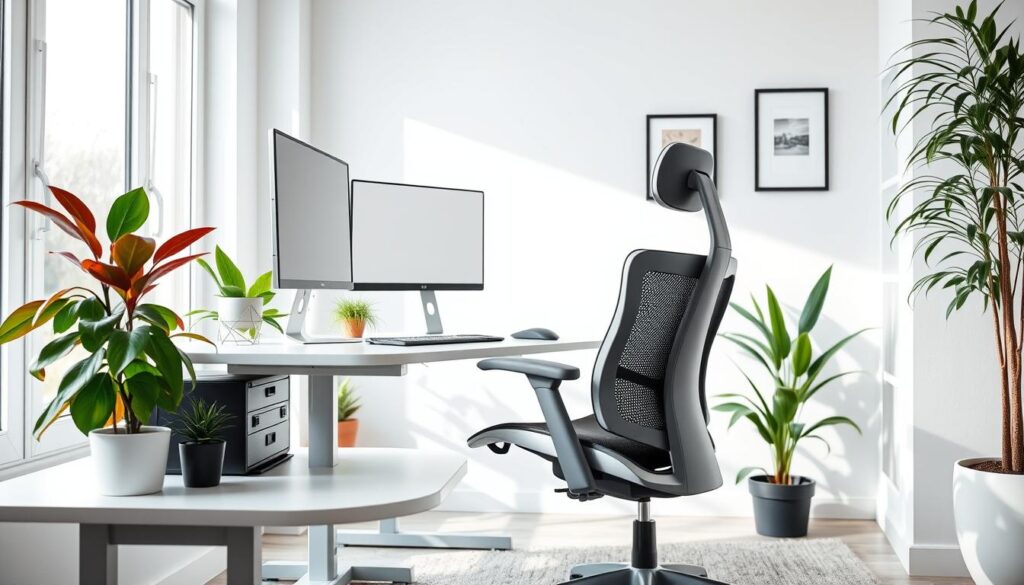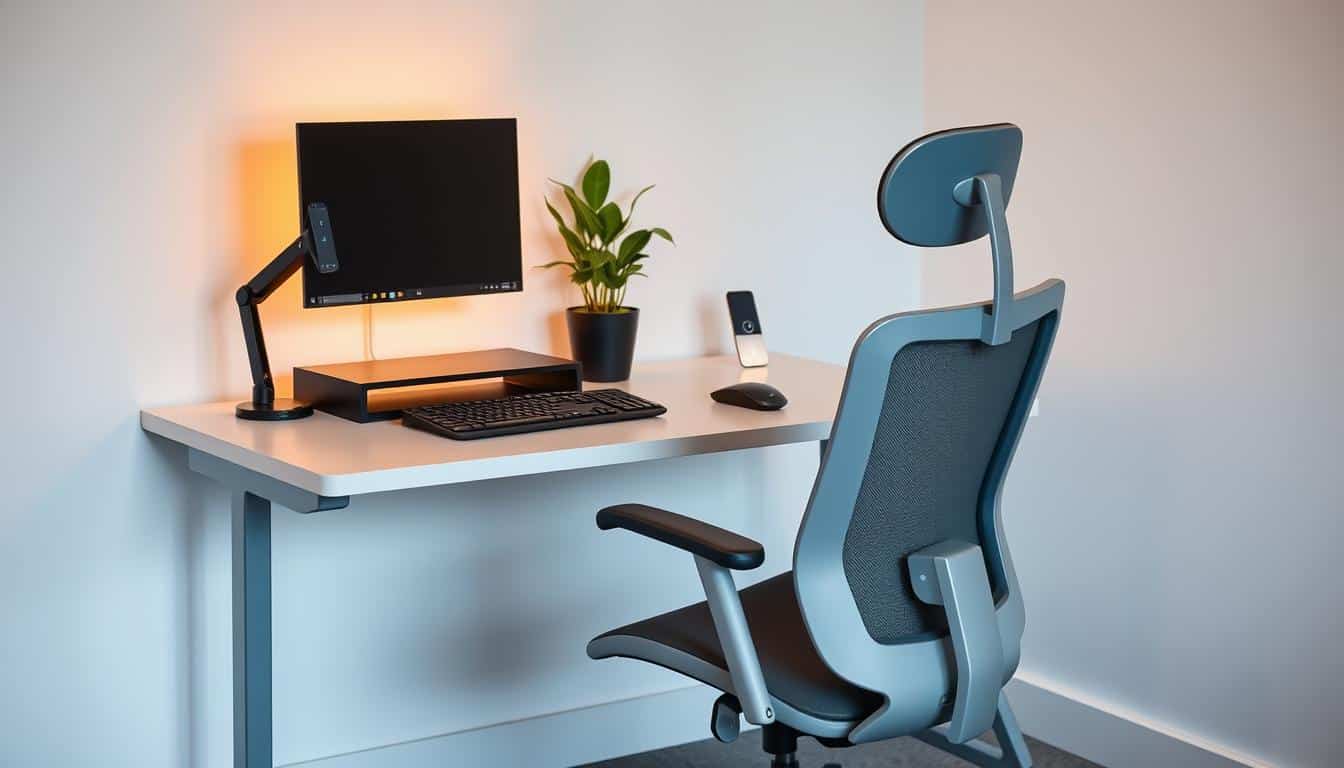Making a tiny home office comfy and productive is important. In small spaces, using every bit wisely matters a lot. This piece shares tips on making your small office work better. By sticking to just what you need, your office can back up your work habits and make you feel better overall.
Understanding the Importance of an Ergonomic Workspace
It’s key to have an ergonomic workspace, especially when working from home. Many people work long hours in tight spaces. So, it’s important to use ergonomic principles to make work better.
Having the right setup reduces aches like back and neck pain. This is key in small home offices where you can end up in bad postures. It makes the work area healthier.
A comfy workspace means more focus and better work. Not being bothered by discomfort boosts productivity. Also, an ergonomic setup makes people happier at work. It keeps them focused and working well.

Key Components of an Ergonomic Layout
An effective ergonomic layout needs several key parts. These parts make the office more ergonomic and boost productivity. When choosing the right elements, you get a comfy and efficient office. Things to think about include:
- Adjustable Chair: It’s crucial to have a chair that supports your lower back and can change height. This helps keep your posture right.
- Desk Height: Your desk’s height should let your elbows bend at 90 degrees while typing. This lessens arm and shoulder stress.
- Monitor Position: The top of your monitor should be at or just below eye level. It eases neck strain and makes viewing more comfortable.
- Keyboard and Mouse Placement: These should be close enough to use without straining. This helps keep your wrists in a natural position.
- Lighting: Good lighting, especially natural light, can help you stay focused. It also lessens eye strain during the day.
These parts are key for a healthy workspace. Adding them to your office helps with productivity. It also makes working a better experience overall.
How to Plan Your Tiny Workspace
Planning a tiny office starts with knowing what you need it to do. It’s important to think about both how it looks and how it works. Start by drawing your office layout. Include where your desk, chair, and places to store things will go. This sketch will help guide your setup.
Then, think about where to put furniture. Place your desk where it gets natural light but no glare on your screen. Easy access to things you use a lot is key for working better.
Look at how much room you have. In small spaces, furniture that does more than one thing is best. Measure your space and pick items that are multi-use, like a desk that also has shelves or a chair you can fold up. Use design tips that help keep your space tidy and flowing well.
A good layout for a tiny office helps you work smoother and stay creative. Even small layout changes can make your space more comfy and efficient. This helps you do more in a smaller space.
Measuring Your Space Effectively
Getting the size of your home office right is key to a good work area. First, write down how long, wide, and tall the room is. Make sure to include spots like windows and places for plugs. These office space dimensions are important for planning.
When you’re looking at a tiny workspace measurement, imagine where your furniture will go. Here are simple steps to measure correctly:
- Use a tape measure for the room’s size.
- Note where windows, doors, and plugs are.
- Think about the size of furniture you need.
- Make sure there’s enough room to move and store things.
Focus on accurate measuring home office details for a tidy and effective work area. It helps with staying on task.
Designing Your Layout for Efficiency
Making your office layout work better is key, especially in small spaces. A smart setup improves both work efficiency and comfort. Place your desk where lots of natural light can come in. This boosts your mood and cuts down on the need for lamps.
Smart storage is also vital for keeping things tidy. Try to keep things simple and clutter-free. Use shelves and furniture with multiple uses. This creates more room, making a small office feel bigger and more open.
Think about how you move around your office. Make sure things you use a lot are easy to get to. Paying attention to these details can really help you get more done. So, these tips for tiny offices are super useful for making the most of your space.
Choosing the Right Furniture for Comfort
Choosing the right office furniture can make a small space more comfortable. A good office chair should support your back well and let you adjust it for your comfort. Look for chairs that can swivel and change height, which help you move easily and feel less tired after working a long time.
For desks, pick ones that fit your space well and have room for your tech gear. Corner or standing desks are great for saving space and keeping you in a good posture. Brands like Herman Miller and Autonomous have desks that you can adjust, perfect for people who need a specific setup.
Maximizing Storage in a Small Office
Tiny offices often face storage issues. However, creative solutions can really help. By arranging your space smartly, everything finds its own spot. This makes work flow better and cuts down on distractions. Adding furniture that serves more than one purpose, like desks with drawers or shelves, is a smart move. It does not just save room but also makes the most of it.
Here are some smart storage ideas for small offices:
- Utilize vertical storage by installing wall-mounted shelves.
- Incorporate a rolling cart for easy access to supplies that can be moved as needed.
- Employ stackable bins or baskets for keeping supplies organized while minimizing clutter.
- Invest in a bookcase that doubles as a divider, providing both storage and layout definition.
By following these tips, you make sure every inch of space works hard. This way, small office storage solutions boost productivity significantly.
Utilizing Vertical Space in Tiny Home Offices
Vertical space can turn a tiny office into a well-organized area. By using walls wisely, you can add lots of storage without taking up floor room. This can make your small workspace both work better and look nicer.
Here are some smart ways to save space:
- Wall Shelves: Putting up strong shelves will let you store books, supplies, and decorations. This keeps your desk area clean.
- Hooks and Pegboards: These can hold many things, from tools to bags. They make it easy to grab what you often use.
- Over-the-Door Organizers: Doors can also hold organizers. They’re great for keeping supplies, paperwork, and tools, using up all possible space.
Using vertical space well makes tiny offices neater and more inspiring. Choosing smart storage solutions can boost your efficiency and create a better work atmosphere.
Setting Up Technology for Optimal Ergonomics
How you set up your office tech is key to working comfortably and efficiently. The right placement of your devices makes a big difference in how you feel at your computer. Putting monitors at eye level helps keep your neck comfortable. This allows you to look down at the screen the way you naturally do.
Here are important things to remember:
- Make sure your keyboard is positioned so your elbows are at a 90-degree angle or more when you type.
- Use ergonomic tools like adjustable stands and keyboard trays to customize your workspace.
- Keep all your cables organized to avoid mess and make sure power sources are easy to reach.
Having fast and reliable internet is crucial for staying productive. A good connection improves your work and reduces the annoyance of slow speeds or interruptions. Arrange your equipment so technology and comfort merge well. This takes advantage of great computer workstation ergonomics.
Decorating Your Tiny Workspace
Making your small home office feel welcoming can really help you get more work done. Start by choosing a color scheme that relaxes you. Then, hang up some art that makes you feel creative and shows off who you are.
Adding plants is a great idea for making your office look better. They clean the air and add a bit of the outdoors. Try to keep things tidy and make sure everything you add has a use. This keeps your office looking good without being too packed.
Creating a space where you love to work is key. Decorate it in a way that feels right for you. This way, your small office will not only look good but also be a place where you enjoy spending time.
Organizing Supplies to Enhance Productivity
Keeping your supplies in order is key to staying focused in a small home office. Using supply organization methods can really cut down on distractions. This helps you get things done faster. Drawer organizers are great for sorting your office items. They make it easy to find what you need.
Putting labels on things makes it clear what’s inside drawers and containers. Having specific bins for stuff like stationery, papers, and tech gear helps use space well. It’s also important to clean out your work area often. This means getting rid of things you don’t need and keeping the essentials.
Putting these productivity tips for home offices into action helps make your space neat and more effective. A well-organized desk area boosts creativity and efficiency. It lets you concentrate on work without the mess slowing you down.
Maintaining a Clutter-Free Environment
Having a clean workspace is crucial for boosting efficiency in small home offices. Using effective ways to reduce clutter makes a big difference. Making cleaning and reordering a habit prevents the pileup of things you don’t need. Even small steps every day can lead to big improvements over time.
- Put things away immediately after use.
- Set aside time each week for tidying up.
- Regularly assess what items are essential for your workspace.
Organizing strategies for small offices keep your space neat. By assigning specific places for all your office items, you cut down on distractions and work better. Aim to have just the things that truly benefit your work area.
Conclusion
Making your small home office ergonomic is key to feeling good and working well. This article showed how an ergonomic office does more than just look nice; it greatly improves your health and job performance. With the tips we talked about, you can turn a tight space into a useful work area that fits your needs.
To better your home office, you need to think about layout and pick the right furniture and places to keep things. Think about how each part of your office affects what you do every day. By focusing on ergonomics, you make working more fun and avoid problems like tiredness and pain, often seen in bad office setups.
Starting a better home office begins with deciding to follow these ideas. By putting these tips into practice, you’ll move towards having a small office that’s both beautiful and good for your work and health. Small details matter a lot when making a comfy, ergonomic space in your small home.



